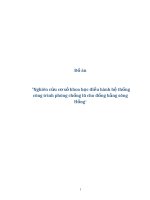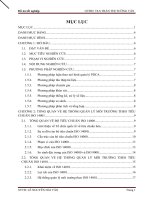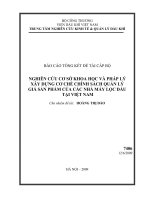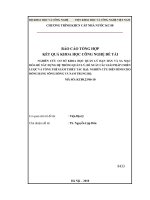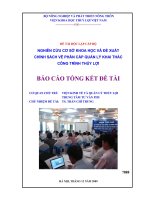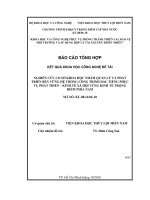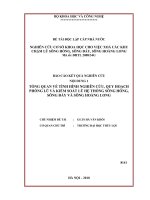Nghiên cứu cơ sở khoa học quản lý tổng hợp khu rừng tràm gáo giồng, tỉnh đồng tháp tt tiếng anh
Bạn đang xem bản rút gọn của tài liệu. Xem và tải ngay bản đầy đủ của tài liệu tại đây (217.03 KB, 34 trang )
1
MINISTRY OF EDUCATION
MINISTRY OF AGRICULTURE
AND TRAINING
AND RURAL DEVELOPMENT
VIETNAMESE ACADEMY OF FOREST SCIENCES
Le Huu Phu
STUDY ON SCIENTIFIC BASIS OF INTEGRATED
MANAGEMENT OF GAO GIONG MELALEUCA FOREST,
DONG THAP PROVINCE
Major: Silviculture
Code: 9620205
SUMMARY OF THE RESEARCH RESULTS
HA NOI - 2019
The thesis is completed at:
Vietnamese Academy of Forest Sciences
2
Scientific guide: Associate Professor Ph.D Ngo Đinh Que
Dr. Nguyen Chi Thanh
Chairman:
Reviewer 1:
Reviewer 2:
Reviewer 3:
The thesis was defended in front of the Institute-level Council at the
Vietnamese Academy of Forest Sciences at . ... .... date .. ... 2019
The thesis can be found at the National Library and Library of the
Vietnamese Academy of Forest Sciences
3
4
Introduction
1. The urgency of the subject
Now the management of Melaleuca forests (MF) in many forest
management units have been implementing as a “single approach”
means that based on mainly Melaleuca forest while other factors of
wetland ecosystem such as water, soil, fauna, flora, landscape,..etc are
not still concerned significantly. Keeping the year-round high water
level to reduce the risk of forest fires has changed from wetlandasonally
inundated ecosystems to year-round inundation, resulting in less
developed melaleuca, wetlandasonally inundated grassland habitats
narrowed from that reduces the habitat of many animals. In addition, the
legal provisions on exploitation and uwetland of natural resources in
special forests are only regulated for forest and special forests in upland
areas, while the resources of wetland in the special forests are in the
wetland not clearly defined.
The Management Board of Gao Giong Forest is managing 1,492.5
ha, located in the Plain of Reeds, which is one of the important
ecoecological areas in the Mekong Delta. The management method of
Melaleuca forest in Gao Giong (MFGG) is to both carry out the
function of conwetlandrving biodiversity, using forest resources
reasonably with the participation of LC.
To promote the values and wisely use natural resources in the
wetland according to the Ramsar convention, titled " Study on
scientific basis of integrated management of GGMF, Dong Thap
province” has been implemented to propose integrated management
methods to meet the goal of forest protection and biodiversity
conservation with rational use of forest resources with the participation
of local communities (LC) as a management measure. synthesize
samples so that MF on other wetlands have similar conditions of
reference, is meaningful and necessary job.
5
2. Objectives
Overall objectives: Proposing a model of management of MF in Gao
Giong based on the scientific basis of the relationship of Melaleuca forest
with the factors of wetland under the approach of ecosystem management
with the participation of LC, exploiting and using natural resources of
MF and wetlands in a sustainable way while maintaining the function and
value of melaleuca and ecosystems.
Specific goal: (i) Determining the effect of inundation regime,
habitat and seasonal regimes on forest and wetland resources as a basis
for proposing a scientific basis for the integrated management of
Melaleuca forest ecosystems; (ii) Proposing an integrated management
model of Melaleuca forest based on the ecological relationship between
Melaleuca forest with local community participationand, linking
conservation with other exploitation, sustainable use and benefit
sharing.
3. The scientific and practical significance of the thesis
Scientific significance: (i) Building scientific arguments as a basis to
propose integrated management solutions for a Melaleuca forest on
wetlands based on the study of natural factors and social factors;; (ii)
Contribute scientific data to a research database of MF and wetland in
Vietnam.
Practical implications: Displaying integrated management measures
of Melaleuca forest in Gao Giong as a sample management
measures for other Melaleuca forest management boards that have the
same conditions for reference and study.
6
4. New point of the thesis
Determining the scientific basis of the management of Melaleuca
forest on the wetland area according to the ecosystem approach based
on the relationship between the elements of MF, herbaceous, animals,
soil under inundation regime and habitats.
Proposing an integrated management model of Melaleuca forest on
the wetland area in Gao Giong, Dong Thap province according to the
purpose of sustainable use of ecosystem resources with the participation
of the local community but still maintaining the functions and value of
melaleuca forest and wetlands
5. Thesis layout
The thesis has 147 pages, including 49 tables, 68 figures, 113
references, and is structured into the following contents:
Introduction: 4 pages
Chapter 1. Overview of studies: 24 pages
Chapter 2. Content and methods: 22 pages
Chapter 3. Result and discussion: 83 pages
Conclusions and recommendations: 2 pages
Published works related to the topic: 1 page
References: 11 pages
7
Appendix
Chapter 1. OVERVIEW OF STUDIES
1.1. Studies in the world
Studies on Melaleuca forest ( Cajuputi Melaleuca Powell )
Melaleuca (cajuputi Melaleuca Powell) referred to as cajuputi
Melaleuca belongs to the Myrtaceae family, is one of 10 species that
constitute
the M.
leucadendra complex ,
also
known
as M. Leucadendron. [20],
[76] . Naturally
distributed
in
Northern Australia and Papua New Guinea. However, this species is
also widely distributed in Southeast Asia such as Indonesia, Malaysia,
Myanmar, Thailand ,
Vietnam
and India [75].
Melaleuca
cajuputi distributes mainly in the coastal regions of the hot and humid
tropics with the highest average temperature in the hottest month is
31 - 33 0 C; The lowest average temperature in the coldest month is
17 - 220 C ; live best in coastal wetlands; in which the soil is formed
from alluvial deposits, rich in organic matter, poor drainage capacity,
low fertility, high sulfate acid [81] .
Studies on wetlands
8
The views of the Ramsar Convention on sustainable management of
the wetland : "Wise use" of the wetland and are defined as follows:
" Maintaining the ecological characteristics of the wetland through
implementing the ecosystem approach in the framework of
development. sustainable ” [102 ]. IUCN has been in charge of water
management according to the ecosystem approach (2009) [32] lists 12
guidelines, which highlight is wetlandeking the appropriate balance and
integration of conwetlandrvation and use of bio-diversity; attract the
participation of stakeholders; and should consider all types of relevant
information, including scientific and indigenous and local knowledge,
innovation and practicality.
The studies on MF management on wetland areas
9
Results of Yamanoshita Takashi (2001) [106] in the Thai wetlands,
the height of the trees during the rainy season is greater than the dry
season. Planted
forest
on
the ridge
is 23.7%
larger
than unrooted plantation (Nakabayashi Kazua (2001). [100]). Results of
the control of Melaleuca quinquenervia in the South East region of
South Florida, United States by biological means more effective
than mechanical measures (Turner
TD
(1998) [107]) ; To prevent
encroachment of alien species and increawetland biodiversity in
wetland areas in South Florida National Park, an integrated
management strategy has been developed , including the participation of
local comunity and encourage economic wetlandctors to
participate (Frank J. Mazzotti (1997) [85]) ; To understand fully the
value ecosystem requires discussion with the community to identify the
wetland ecosystem services from countries and areas of wetland,
which has emphasized the role of indigenous knowledge of local
community (Russi (2013) [105] ); To sustainable use of wetlands
according to the ecosystem approach has been highly consensus of
stakeholder when harmonizing the aspects of social, environmental and
economic benefits. (Harrington (2011) [87]) .
In summary, the management of melaleuca and wetlands in the
world is based on the goal of integrated management, not only for
economic purposes, managing and using all the ecosystems of the
wetlands with the participation of local community and harmonious
settlement of social, environmental and economic benefits.
1.2. Studies in Vietnam
Studies on melaleuca forest (Melaleuca cajuputi Powell)
10
According to Thai Van Trung (1998) [67], Melaleuca is a dominant
species in the ecosystem of aluminundated forest in the Mekong Delta,
is a component of the ecosystem of alum, the growth and development
of MF have a clowetland relationship. clowetland to the rural
environment. In addition, Melaleuca can’t tolerate high salinity, If
salinity is > 20 ‰ will kill the plant. The deeper the water is submerged
in, the longer the flooding time, the more negative affect the growth of
MF (Do Dinh Sam (2001) [51]).
The studies on wetlands
The results of rewetlandarch on acid sulphate soil in Plain of Reeds
mainly go into classification, description of soil formation process and
soil mapping (Phan Lieu et al., 1998) [33], Besides, there is also a study
to assess the potential of using acid sulphate soil in forestry production
and divide the site types to plant MF on the Mekong Delta alum soil
(Do Dinh Sam et al, 2001, 2005 [51 ], [52]). However, these studies are
large-scale, when specific application in Gao Giong will not show all
the soil characteristics in the study area.
Nguyen Chi Thanh (2007) [57], has developed a system of
classification of wetlands in the Mekong Delta, include 4
levels: System, Sub-system, Class, Sub-class. Thereby, it is shown that
the classification of wetlands according to the system shows the
viewpoint of wetlands as a ecosystem. In particular, Melaleuca forest in
Gao Giong is located in the regular or irregular submerged freshwater
layer, belonging to the sub-system of the lagoon.
The studies on MF management on wetland areas
11
The fact that the water level has been kept high for many months in
the year to limit forest fires in Tram Chim National Park has caused
degradation of ecosystems, the area of grass communities with the main
food of crane and rice has decreased quickly, the Melaleuca forest
community is underdeveloped or collapwetlandd, the quality of the
water inside is declining [70]; The research results of Tran Van Thang
(2017) [61] show that the depth of inundation and long-term flooding
are the caused of degradation of plant ecosystems in U Minh Thuong
National Park. In order to maintain the Melaleuca forest biodiversity,
the maximum flood water level is not more than 40cm, the duration of
flooding should not exceed 6 months.
Studies on the level of hydrolysis relationship with Melaleuca forest
fire in U Minh Thuong National Park [61], Procedures for fire prevention
and fighting of Melaleuca forest [14] assessed and analyzed the
relationship between water level and forest fire. However, thewetland
studies have not paid attention to the humidity of air, fire materials ...
Melaleuca forest accounts for only 57.7% of the total natural area of
special-use forests area in the Mekong Delta, Melaleuca forest is only
one of the components of wetland ecosystem. The rest are grasslands,
canals, ditches ...
Buffer zone with regulations on management and benefit sharing
approved by local community, approved by People's Committee, only in
Tram Chim National Park.
The participation in the development of ecotourism LC is limited, no
coordination mechanism, demonstrating responsibility, rights and
obligations.
12
Policies to support local community in the nature reserve areas
mainly focus on forest objects, this is only suitable for special-use
forests in upland areas, and special-use forests areas in the wetland
have not been paid attention.
General discussion:
The results of scientific on the world and domestic confirmed that
melaleuca forest is a key component of the wetland ecosystem. Wanting
to manage MF in a sustainable way, it must be based on the
management of wetland ecosystems. In addition, the general approach
of the world in managing wetlands resources is to wisely use resources
with central human factor living inside and adjacent to MF and
wetlands. One of the most effective management tools for MF and
wetland is the participation of LC. This is the weakness of many
Melaleuca forest management boards in the Mekong Delta while doing
quite well in the Gao Giong melaleuca forest (GGMF) management
board.
13
There have been many studies of melaleuca forest, prevention of
melaleuca forest fire, the relationship between melaleuca forest with
flood depth, the relationship between melaleuca forest and vegetation
with soil and biodiversity in forest. Melaleuca, composition of fish
species in MF ... These studies are very valuable in science and
practice. But no no research has shown the characteristics and
relationship between MF and wetlands according to the approach of
ecosystems, so no work has found a general management model of MF
and a wetland effective way, in accordance with the world's
management principles of ecosystems. The topic "Study on scientific
basis of integrated management of GGMF, Dong Thap province" will
contribute to introducing a method to manage melaleuca forest based on
the wetland ecosystem with the participation of LC to contribute to the
sustainable management of MF in the Mekong Delta in particular and
the country in general.
Chapter 2. CONTENT AND METHOD
2.1. Content
- Characteristics of Melaleuca forest.
- Characteristics of flooding regime (FR) and soil .
- Effects of FR, habitat and sesonal on forest resources.
- Characteristics of the community and the management of forest
resources in Gao Giong, Dong Thap province.
- Proposing measures for integrated management of MF on the
wetlands .
14
2.2. Methods
2.2.1. Approach
- According to the ecosystem approach: Melaleuca forest is only one
of the factors of the ecosystem of the wetland, it should not be managed
according to the individual approach of Melaleuca but must be
managed on the basis of the ecosystem of the wetland .
- Seasonal approach, FR and habitats: Study the effects of flooding,
habitat and seasonal regimes to plant and animal species because each
season has different FR, each of which is the distribution of different
plant and animal species
- System approach: Not only study natural factors (MF, soil, water,
plant and animal) but also study social factors (community
characteristics
and
organization,
management).
Forest
management Approach map shown in Figure 2.1.
2.2.2. Methods of collecting and processing data
a. Investigate current status of melaleuca and herbaceous plants
- Determine the forest status through forest planting design
documents and field survey results .
- Established 104 standard plots of 500m2 (25m x 20m) to collect
trunk diameter indicators (D1.3 cm); The height of the tops (Hvn, m).
- Established 70 survey plots of 1m 2 with 2 replications (rainy and
dry season) to collect information : species , vegetation cover.
15
Natural factors:
Social fa
Characteristics of Melaleuca forest (Relationship to flooding regime)
Status of manag
Planning functi
Characteristics of herbaceous plants and fish (Relationship to flooding regime and
Benefit sharing of forest re
Forecast of fores
Characteristics of birds, reptiles, amphibians, animals (Relationship to season/h
Lessons on manag
Create a scientific basis
Create a prac
Integrated management measures of Melaleuca fore
16
17
Figure 2.1. Diagram showing approach of this thesis
b. Investigate on the FR and soil
- Study FR and water quality: Collect water samples at the points for
6 water regimes and 1 outside point for control. Time data collection:
The rainy season: First time: At the end of the flood season (December
2014); 2nd time: Early flood season (September - October 2015); Dry
season: Mid-dry season (April 2015), Water indicators are measured by
specialized machines.
- Investigating soil in Gao Giong area: Inheriting land maps that
have been built in the study area; Then the soil sample was at 7 points,
the soil sampling location coincided with the collection of herbaceous
plants. Analysis of soil properties according to the Vietnam
Standards at the Southern Institute of Forest Science .
d. Animal character investigation:
- The survey and collection of specimens in the field were conducted
3 times: The first time is the 2014 rainy season (November 2014), the
second time is the dry season 2015 (April 2015) and the third time is the
2015 rainy season (September 2015). Collect samples, fish sampling
position coincides with water sampling position, 6 points represent 6 FR
and 1 control point.
- Investigation of animal characteristics: Investigation on 6 routes ,
routes passing through different habitats.
+ Animal survey: Performed in places where locals think it is
common. Field surveys were conducted both day and night by walking
at a speed of 1 - 1.5 km/h.
+ Bird survey: Assessing the relative abundance of birds based on
MacKinnon list. The bird survey time is concentrated in the early
morning and evening. In addition, a night survey was conducted to
record the behavioral birds at night.
18
+ Investigation of amphibians and reptiles: It is done both day and
night. On the survey line, all individuals of each species were recorded
on the survey line to calculate the relative density.
+ Using software such as: PRIMER 6, Excel to process and analyze
data, identify diverse indicators, analyze species distribution, analyze
the grouping of species, families, communities.
2.2.2.5. Residential characteristics and management status
a. Investigation of characteristics of residential communities
- Using participatory rural assessment method (PRA) with farmer
interview tool (104 households) on population, labor, ethnicity, income
data, activities affecting the Gao Giong MF, and conduct mapping of
population clusters.
- Forecast of forest fire : About the time of forest fire risk: Collect
data on average temperature and rainfall in the last 12 years to calculate
the drought index by Thai Van Trung (1998) [67] ; About the risk of
forest fires: Arranged 9 points, at each level conducted: leveling of
water level, setting cells of 1m2 size to measure S% (% vegetation
dry), Arrivals machine to measure air temperature and humidity
(Clock/Humidity) to determine fire levels according to the Ministry of
Agriculture and Rural Development [12].
Chapter 3. RESULTS AND DISCUSSION
3.1. Characteristics of melaleuca forest
19
The area of Melaleuca forest is 1,273.0 ha, accounting for 85.3% and
the habitats of grasslands, canals and canals are 135.9 ha, accounting for
9.1%, the rest are other types of land.
Table 3.1 . The growth index of Melaleuca forest at age I to IV
Age
Index
level
Mean
TI
(cm)
G
2
M
(m)
(m /ha)
(m3/ha)
6,1
55,4
175,0
Max-min
6.100
2,2
0,9
54,7
168,1
Sd
1.468
0,7
0,3
15,6
50,1
8,0
12,5
4,5
28,1
28,6
Mean
14.971
7,2
7,7
64,7
257,9
Max-min
18.400
2,5
7,5
96,3
473,8
4.066
0,6
1,9
22,7
115,2
27,2
8,4
35,0
44,7
13.947
8,1
9,4
75,6
375,1
Max-min
8.300
4,0
6,4
60,7
453,5
Sd
2.309
1,1
1,5
16,7
124,2
16,6
13,7
15,5
22,1
33,1
10.319
9,6
75,0
409,5
Max-min
9.600
2,1
2,3
53,3
307,3
Sd
2.967
0,7
0,7
18,1
109,2
28,8
7,7
6,8
24,2
26,7
Sd
Mean
Cv (%)
Mean
TIV
(tree/ha)
H
6,0
Cv (%)
TIII
D1,3m
18.400
Cv (%)
TII
N
Cv (%)
25,
0
10,
8
20
Note: Sd: Standard Deviation Cv: Coefficient of variation; Each age level is 3 years
The coefficient of variation of the melaleuca forest density is very
small (8%), then increases very rapidly at age level II (27.2%), the age
level III (16.6%) and age level IV (28.8%). Compared to the initial
planting density of about 20,000 trees/ha, the proportion of remaining
average trees at the age levels of I, II, III and IV is 92.0%, respectively;
74.9%; 69.7% and 51.6%.
The coefficient of variation of diameter occurs very strongly at the
age level III (13.7%); Next at the age levels of I, II, IV are 12.5%, 8.4%
and 7.7%, respectively; The coefficient of variation of height occurs at
the highest at age level II (25.0%); Next at age level II, IV and I are
15.5%, 6.8% and 4.5% respectively; The coefficient of variation of
volume occurs most strongly at the age level II (44.7%); Next at the age
levels of III, I and IV are 33.1%, 28.6% and 26.7%, respectively. In
general, the volume of melaleuca forest varies greatly due to different
planting, tending and FR.
3.2. Characteristics of FR and soil
a. Characteristics of FR
The study area has 6 FR, of which the flooded regime 3 accounts for
the largest area (616.7 ha, accounting for 41.3%) and the flooded
regime 6 accounts for the smallest area (14.1 ha, accounting for 0.9%).
21
Table 3. 3 Distribution of area according to the FR
FR level
Symbol
Area
(ha)
Rati
o%
Explain
1
10 - 30cm flood, the flooding time is 13 months in the rainy season; the dry
season is not flooded
203.2
13.6
2
10 - 30cm flood, the flooding time is 56 months in evrery season
124
8.3
3
flood level <10cm, the flooding time is
1-3 months in the rainy season; the dry
season is not flooded
616.7
41.3
4
flood level <10cm, the flooding time is
5-6 months in evrery season
193.3
13
5
10 - 30cm flood, the flooding time is 56 months in the rainy season; the dry
season is not flooded
212.5
14.2
6
Flood level is 30-60cm in rainy season
and 10 - 30cm in dry season; the
flooding time is 5-6 months in evrery
season
14.1
0.9
48.6
8.6
1,492.
5
100
Channels and ditches…
Total
22
b. Water quality
- The concentration of dissolved oxygen (DO) at the sampling points
in the dry seaon and the rainy season are at ≥ 4 mg/l and suitable for
aquatic life and development.
- The total value of dissolved solids (TDS) in both seasons is much
smaller than the limit value ≤ 1,000mg / l and very suitable in protecting
aquatic life.
- pH (H2O) ranges from 4.06 to 6.38, suitable for aquatic plants and
animals in the water environment of alum.
- Temperature
measurements.
(t):
Temperature
does
not
differ
between
- Electrical Conductivity (EC): EC has a great relationship with
salinity, in the range of 135 - 449 µS/cm, indicating that the water is not
saline.
- Salinity (Sal): less than 0.5 o/oo shows that saline intrusion due to
climate change has not affected the study area.
c. Soil characteristics
- Potential alkaline soil in the shallow layer, the soil is very
acidic, pH (H 2 0) is in the range of 3.41 - 4.14, the content of Al 3+ ,
Fe 3+ and sulfur (SO32-) are average.
23
- Content of organic carbon (OC), total nitrogen (N), Lan total
(P 2O5) and potassium total (K2O) in soil were lower than the index
average troops are in acid sulfate soil Viet Nam.
- The easily digested substances: Phosphorus content is at the level
of ≤ 5mg/100g, the potassium content at the poor level in the FR 3, 6,
5; average in FR 1, 2; and rich in FR 4.
- Ingredients meat ạng d motorized heavy clay (Silty Clay Loam).
- Cation exchange: The average value of Ca2 +, Mg2 + and cation
exchange capacity in soil is very low compared to average value in acid
sulfate soil Viet Nam.
3.3. Effects of FR, habitat and seasonal on forest resources
a. Effect of FR on growth index (D1.3m, Hvn) melaleuca forest
In the flooded regime of 5, D1,3m and Hvn, the average is larger in
the remaining submerged regimes. However, the difference in D1,3m is
statistically significant (P <0.05) at age level of II, III, IV and H vn at the
age level of II, IV. In accordance with the research results of Le Minh Loc
(2005) [34], Tran Thi Kim Hong [29], Tran Van Thang [61].
b. Effect of FR and seasonal on herbaceous plants
- 51 species of herbaceous plants have been recorded. Biodiversity in
FR in the rainy season is higher than in the dry season.
24
- Biodiversity in the FR 6 is the lowest, regardless of the dry season
or the rainy season because this area is surrounded by dike system,
water is not circulated from outside, soil is dry, Index: DO and pH are
low; high TDS, so few plants adapt very little.
In the rainy season: The biodiversity in the FR 3 is higher than other
FR because this area in the dry season is exhausted, the decay of plants
is quickly decomposed and when the flood comes, they will bring seeds
and it will be exposed to the soil surface and growth and development.
- In the dry season: Biodiversity in the FR 4 is higher than other FR,
although it is the dry season but the area is still flooded so it is suitable
for many herbaceous plants.
c. Effect of FR and seasonal on fish species
- 85 species of fish have been recorded, showing a high species
diversity and biodiversity in the rainy season is higher than the dry season.
- Biodiversity in FR 7, 2 is higher than the remaining FR in both
seasons. Because it has direct contact with the Mekong River, the DO in
the country is high, so fish species are richer in other FR in the field.
d. Effect of habitat and seaonal on birds
25
69 bird species have been recorded, accounting for 27.9% (69/247
species) of total bird species in the Mekong Delta. The Biodiversity in
the highest habitat of Melaleuca forest, excluding the dry season or
rainy season, the second is the seasonally inundated grassland habitat,
the third is the canal habitat and finally the agricultural habitat. The
number of bird species in similar areas in the Mekong Delta such as Bac
Lieu bird garden has 70 species of birds; Lung Ngoc Hoang has 50
species. It shows that there is a quite diverse and abundant bird fauna
here, including 23 waterbird species
e. Effect of habitat and resonal on reptiles
13 species have been recorded, the biodiversity in the habitat of the
Melaleuca forest is highest and the dry season is lower than the rainy
season because the water level is low and many species tend to move
deep into areas with water in the melaleuca forest, so almost all species
are recorded in this habitat. In the grassland habitat and the canals,
when the water level decreases, the habitat of these species is also
reduced, so fewer species are recorded in the dry season than the rainy
season. At the agricultural habitat: in the dry season is the harvest
season so there is no habitat for reptiles and the probability of catching
is not high.
g. Impact of habitat and resonal on amphibian species
5 species have been recorded, the highest biodiversity in the habitat
of MF, excluding of the dry season or the rainy season, because this is
the place to maintain a favorable environment for amphibians species to
live and good coverage to help melaleuca forest areas to maintain high
humidity, hold water and limit direct light. In agricultural habitat has
low biodiversity due to human impact.
